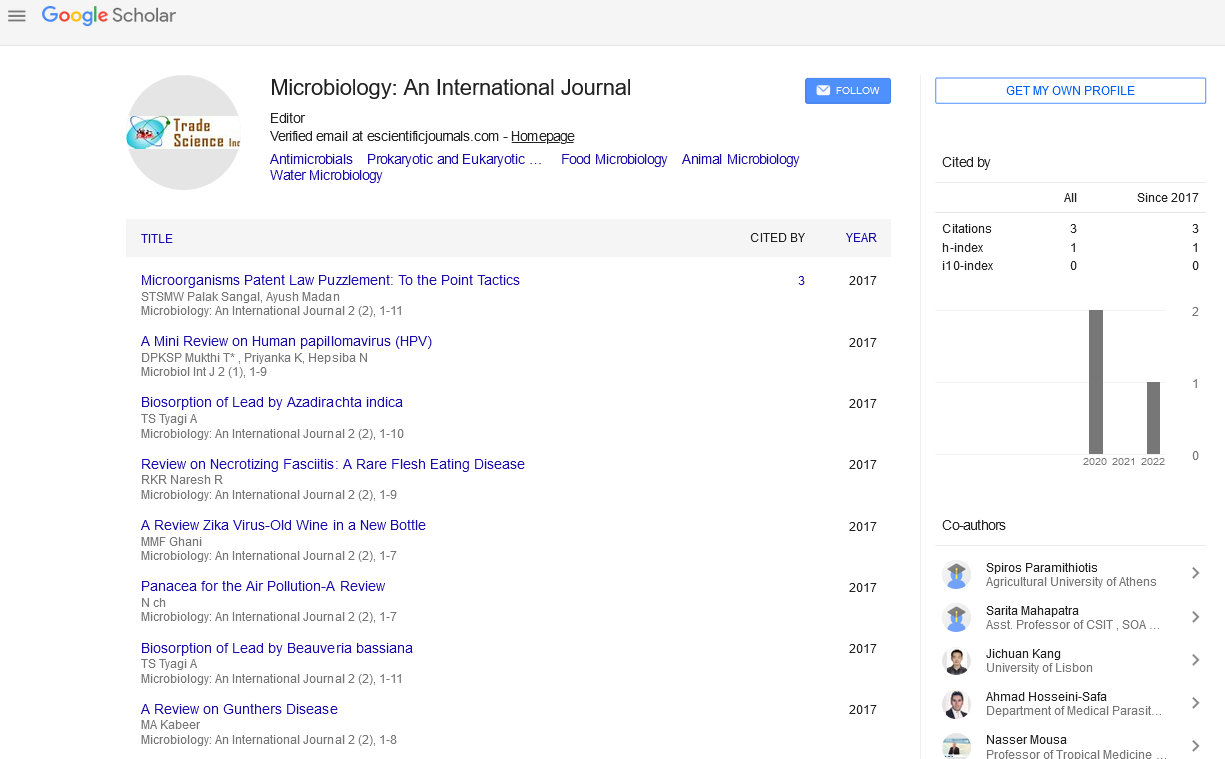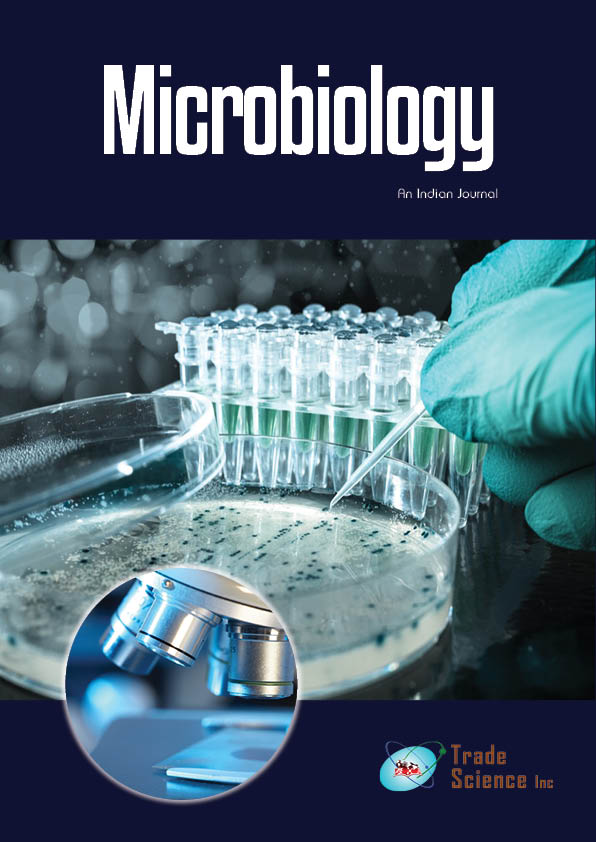Review
, Volume: 4( 1) DOI: 10.37532/tsmy.2022.4(1).136Isolates of Pseudomonas Aeruginosa from Cystic Fibrosis Patients
- *Correspondence:
- Beriny Sandra
Department of Health Science, Ontario Tech University, Oshawa, Canada; E-mail: Sandra.b@hsotu.edu
Received: 30-Jan-2022, Manuscript No. TSMY-22-56958; Editor assigned: 01-Feb-2022, PreQC No. TSMY-22-56958(PQ); Reviewed: 15-Feb-2022, QC No. TSMY-22-56958; Revised: 20-Feb-2022, Manuscript No. TSMY-22-56958(R); Published: 28-Feb-2022, DOI: 10.37532/tsmy.2022.4(1).136
Citation: Sandra B. Isolates of Pseudomonas Aeruginosa from Cystic Fibrosis Patients. Microbiol Int J. 2022;4(1):136.
Abstract
In cystic fibrosis (CF) chronic lung infections, Pseudomonas aeruginosa is thought to form as a biofilm. P. aeruginosa adhesion to both biotic and abiotic surfaces has been linked to bacterial cell motility. We used molecular and microscopic methods to identify the presence or absence of motility in P. aeruginosa CF isolates, and we statistically associated this with their ability to form biofilms in vitro. Our research revealed a wide range of biofilm generation, architecture, and regulatory mechanisms. Biofilm production ability was measured using microtitre plate assays, with phenotypes ranging from biofilm deficient to those that developed highly thick biofilms. Individual strains with swimming and twitching motility had a beneficial effect on biofilm biomass, according to a comparison of their motility and adhesion qualities. Importantly, motility was not a necessity for biofilm development; non-motile isolates created thick biofilms, and three motile isolates with both flagella and type IV pili adhered only weakly formed biofilms. Furthermore, CLSM analysis revealed that P. aeruginosa biofilm-forming strains were capable of entrapping non-biofilm forming strains, allowing these 'non-biofilm forming' cells to be detected as part of the mature biofilm architecture. Clinical isolates that don't form biofilms in the lab need to be able to live in the lungs of patients.
Keywords
Chronic infection, Cystic Fibrosis, Genotyping, Pseudomonas Aeruginosa, Virulence.
Introduction
P. aeruginosa, a bacterial pathogen, may adhere to a variety of epithelial cells, and this is thought to be the first stage in colonising the lungs in people with CF. P. aeruginosa predominated in aggregates in sputum samples from CF patients, enclosed in the biofilm-thriving bacteria's distinctive extracellular matrix. The non-mucoid, fastgrowing, and generally antibiotic-resistant P. aeruginosa strains that infect the CF lung early on are similar to those prevalent in the environment. During a long-term infection, however, the bacteria adapt to the CF patient's airway environment by accumulating loss-of-function mutations and genetic adaptability [1].
A mutation in the mucA gene, for example, allows the phenotypic to go from non-mucoid to mucoid, alginateoverproducing. Other phenotypic alterations include the loss of flagella or pilus-mediated motility, the loss of lipopolysaccharide (LPS) O-antigen components, the advent of auxotrophic variations, and the loss of pyocyanin synthesis, as well as the rise of multiple antibiotic resistant strains. This phenotypic shift during chronic infection is most likely an adaptive response that allows P. aeruginosa isolates to survive in the CF lung's unfavourable environment [2].
Several studies have looked at the role of bacterial motility in biofilm formation and development, both as a method of establishing contact with an abiotic surface and as a means of initiating contact with an abiotic surface. P. aeruginosa can move in three different ways. On solid surfaces, type IV pili mediate twitching motility, whereas the flagellum mediates swimming and swarming motility in aquatic conditions. In semisolid settings, a shift from swimming to swarming motility is thought to occur (e.g. agar or mucus) [3].
Flagella-mediated motility brings cells closer to surfaces, overcoming repellent forces between the bacteria and the surface it will attach to. It's been claimed that the flagellum also functions as an adhesin, and Sauer found that nonflagellated P. aeruginosa mutants have lower attachment efficiency than the wild type. Twitching motility is a sort of surface translocation mediated by type IV pili, which play a role in biofilm architecture and are responsible for the creation of biofilm microcolonies [4].
Inflammation is an important part of the body's natural defence against infection. Macrophages, or sentinel cells of the innate immune system, play a critical role in lung and airway defence against viruses, bacteria, mycobacteria, and fungi, and are involved in both innate and acquired immunity in the respiratory tract. To increase inflammation during infection, macrophages build a cell signalling platform known as the inflammasome. When inflammasomes are assembled, they activate caspase-1, which causes the processing and release of IL-1b and IL-18, as well as pyroptosis, which is a type of inflammatory cell death. The caspase-1 inflammasome is activated in response to a range of pathogens and damage-related ligands; however, certain stimuli may also trigger a noncanonical inflammasome that is dependent on caspase-11 [5].
Conclusion
The CF P. aeruginosa biofilm in the mixed biofilm scenario in vitro could contain a variety of isolates, some of which are incapable to produce biofilms but can colonise an existing biofilm. Adaptability is essential for effective colonisation of an environmental niche, and it is well understood in the field of infectious disease that a pathogen will typically have many harmful mechanisms. As a result, many pathogens have a variety of adhesion mechanisms that enable them to connect to epithelial cells, for example. We believe that the physiological mechanisms involved in biofilm development should be viewed in the same light, because a defect in one phenotypic element of biofilm formation may be compensated for by other genetic and phenotypic characteristics. Motility aids biofilm development in P. aeruginosa CF isolates, although it is not a prerequisite. It is obvious that CF isolates with different motility characteristics can create a mixed biofilm when they work together. This could provide bacterial populations an advantage because they would have a larger genetic repertoire, allowing them to adapt to varied obstacles such as antibiotic treatment, host inflammatory reactions, and so on.
References
- Christensen SK, Pedersen K, Hansen FG, et al. Toxin–antitoxin loci as stress-response-elements: ChpAK/MazF and ChpBK cleave translated RNAs and are counteracted by tmRNA. J Mol Bio. 2003;332(4):809-819.
- Lawrence JR, Korber DR, Hoyle BD, et al. Optical sectioning of microbial biofilms. J Bacteriology. 1991;173(20):6558-6567.
- Hoiby N, Johansen HK, Moser C, et al. Pseudomonas aeruginosa and the in vitro and in vivo biofilm mode of growth. Micro Infec. 2001;3(1):23-35.
- Koch B, Jensen LE, Nybroe O. A panel of Tn7-based vectors for insertion of the gfp marker gene or for delivery of cloned DNA into Gram-negative bacteria at a neutral chromosomal site. J Micro Methods. 2001;45(3):187-195.
- Lee B, Haagensen JA, Ciofu O, et al. Heterogeneity of biofilms formed by nonmucoid Pseudomonas aeruginosa isolates from patients with cystic fibrosis. J Clin Micro. 2005;43(10):5247-5255.
Indexed at, Google Scholar, Cross Ref
Indexed at, Google Scholar, Cross Ref
Indexed at, Google Scholar, Cross Ref
Indexed at, Google Scholar, Cross Ref

